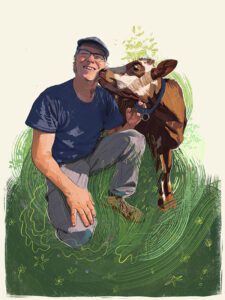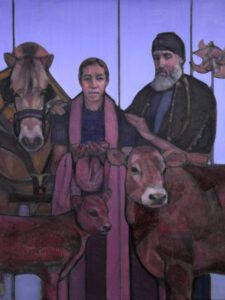By RJ Crowley, Standard Correspondent
April 4 to June 23, Billings Farm & Museum’s Historic Barn, in partnership with Vital Communities, will host “Portraits of Resilience: Farming in a Changing Climate” — an exhibition featuring 26 original artworks by local artists. The exhibition offers an opportunity for the public to learn how area farmers are adapting to environmental challenges and what each of us can do to help sustain our farms and food sources.

Artist Cecily Anderson created this work, one of over two dozen pieces of art on display at Billings beginning April 4 Courtesy of Billings Farm & Museum
Christine Scales, Director of Education & Interpretation at Billings Farm & Museum spoke of the genesis for this topical, urgent and artistically infused exhibition: “It dates back to last summer when Vital Communities created their ‘Climate Farmers Stories,’ which paired local artists with local farms in an effort to promote public awareness and highlight the serious challenges that our farmers face due to the severe impact of climate change,” Scales noted.
Sherlock Terry, the Curatorial & Exhibits Manager at Billings, has been working alongside Scales to create the exhibit.
“We thought maybe there’s a place for us in all of this that allows this artwork to be shown,” Terry said.
So, in association with Vital Communities, the tandem of Scales and Terry at Billings Farm & Museum have put together a multi-layered, educational and thought-provoking experience that opens on April 4 and runs through June 23.
In addition to the artwork — which features a portrait intentionally crafted by local artists to connect viewers with farmers — seven different educational panels inform the viewer on a myriad of different topics as they relate to climate change. For example, there is an introductory panel on the science of climate change, while other panels examine “best practices” that farmers are implementing. The “Art for Action” panel explores how art can be a form of activism and depicts how people can act in a certain way to support our farms. Another panel is devoted to Billings Farm itself, and the adaptive practices it has employed as a result of climate change.
“Last year, in July during the flood, we were devastated,” Scales recalled. “We lost all of our hay down the river. All of our hayfields were flooded, and we lost acres and acres of hay land. This caused a lot of change in terms of farm practices we’ve adapted to.”

Cedar Mountain Farm in Hartland was paired with artist Janet McKenzie, who created this piece and donated it to the farm.
Courtesy of Billings Farm & Museum
In addition to offering resources for taking action, Billings Farm will demonstrate techniques during the exhibition, such as rotational grazing and low or no-till fields, that climate farmers are implementing. This extension of the exhibition allows guests to see firsthand how a working farm improves its climate resiliency.
Along with the artwork, and the interpretive panels, the exhibition will also feature a resource station, as well as an activities area for children (and parents) where they can enjoy building their own farm, using things like solar panels, electric tractors and more.
“People can start familiarizing themselves with what an adaptive farm might look like that’s more responsive to the environment,” said Terry.
Scales and Terry have created an experience that offers compelling art, enlightenment and education — all in an effort to tell a very important story — the plight of our local farmers, and how they are desperately working to adapt to a very challenging new normal.
One of the farms featured in the exhibit is Kiss the Cow Farm in Barnard, owned and operated by Randy and Lisa Robar.
“It rained all summer last year,” Robar observed, “and the summer before that, we were in a drought, and it seems like mud season this year began in mid-December. I’ve got a neighbor who’s 75 years old and he put it succinctly when he said: ‘weather is different.’”
Scales had a similar take when she said, “Farmers used to be able to predict what would happen in any given year based upon their years of experience, but things are changing so rapidly that there is a sense of whiplash, in not knowing quite what to expect. And also, how do you plan for the unexpected while still remaining nimble and adaptive?”
“These farmers really want their stories to be heard and want people to understand what they’re going through, and how dire the situation is,” Terry explained.
Yet the strength and determination of our local farmers is anything but ephemeral. The title of the exhibition, after all, emphasizes resilience.
And with that in mind, the exhibit has already had a positive effect on the local farms involved. Scales and Terry say that as a result of this project spawned by Vital Communities and enhanced by Billings Farm, farmers have built a network of collective strength and have learned from one another as a result of their shared experiences.
The plight of our local farmers is the plight of all of us, and Billings Farm is providing an important and necessary platform to express not just the challenges our farmers face, but the solutions and best practices we can all engage in as we face an uncertain future.
For more information on this exhibition, visit billingsfarm.org.